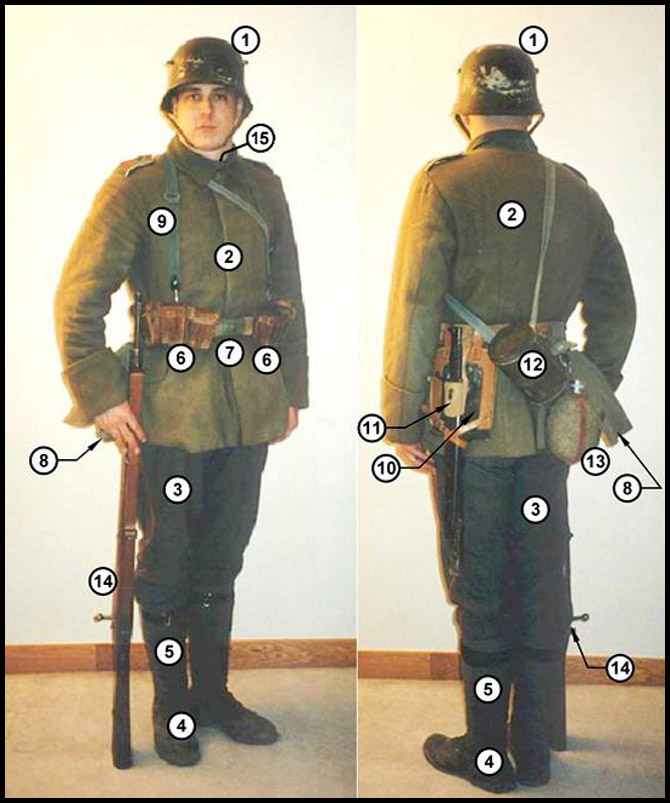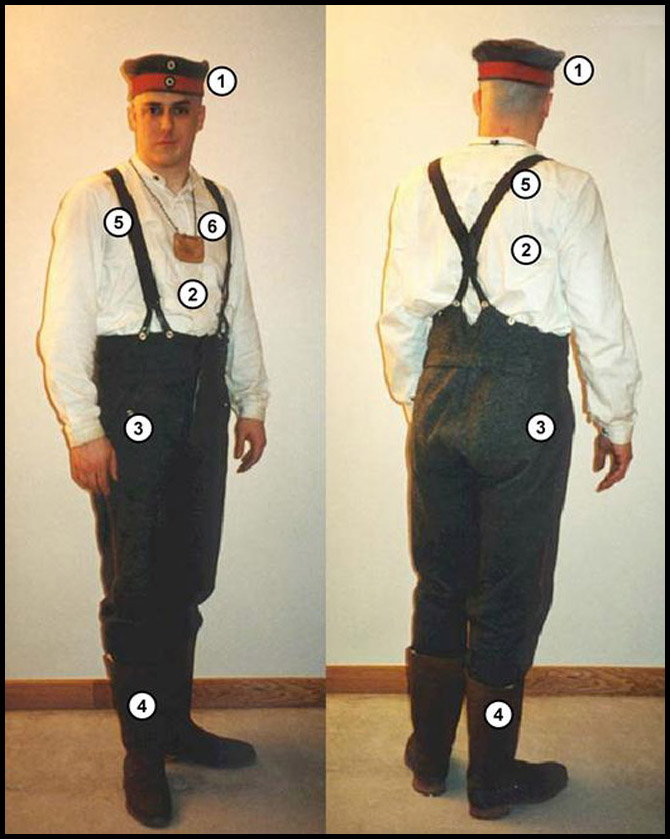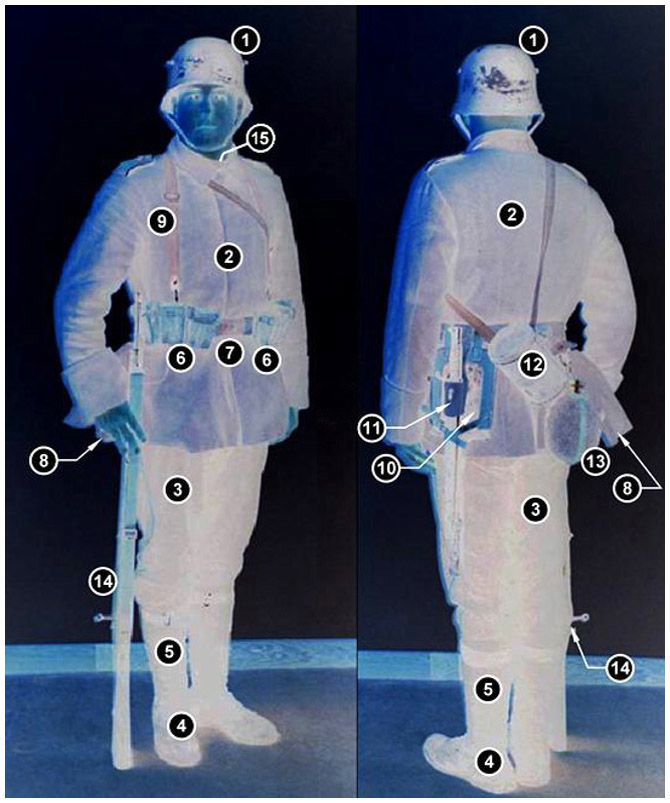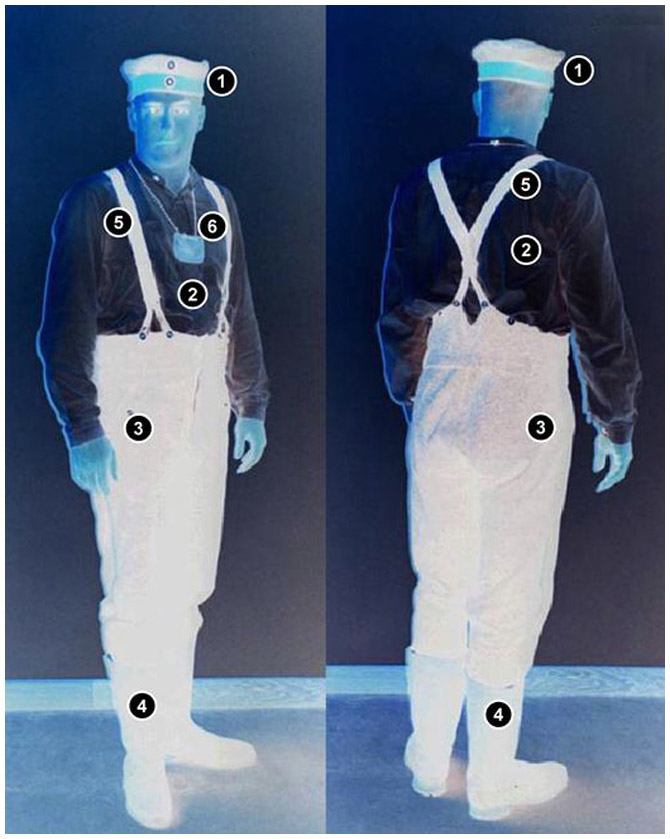Main Menu

Guidelines for Prospective Members
Infanterieregiment Nr. 63 is a vehicle through which committed persons can actively explore the experience of the German Infantryman in the Great War. Gathered together in the form of a typical Infanterie Kompanie, we strive to investigate the art of trench warfare. Each member may have different motives, but collectively our goal is the same. We seek to encounter, within reasonable bounds, the lessons of the Western Front, thus gaining greater insight into ourselves and history.
Like all select brotherhoods, Infanterieregiment 63 insists on the highest standards from its membership. To be counted as a Kamerad of JR63 one must believe in excellence and precision and by nature be assertive, mature, and willing to work side-by-side as part of a team. Together we achieve that which is beyond mere individualism. It is just this spirit of fellowship that binds each member to his Brothers-in-Arms and allows him to fully understand the meaning of Kameradschaft.
Reenacting, Reenactments and Reenactors
Infanterie-Regiment 63 is part of a larger parent organization, the Great War Association (GWA). The GWA strives to honor the original participants of the First World War through battle reenactments and educational activities. Our membership experiences many of the sights and sounds of the 20th Century's most horrible conflict. This occurs at the Caesar Krauss Great War Memorial Site near Newville, Pennsylvania, which has an authentically recreated portion of the Western Front as it may have appeared circa 1917-1918. The reenactors in these recreations wear carefully reproduced uniforms and equipment of both the Central Powers and Allied armies. The use of original drill and tactics is also emphasized in WWI reenacting.
Our battle reenactments take place within systems of opposing trenches complete with a crater pocked No-Man's Land. There are also belts of barbed wire, which are used to protect the sandbagged front line trenches, and are punctuated by bunkers with functioning machine-guns. Behind the main lines are many supporting and communication trenches, which are connected to underground dugouts, where the officers plan attacks and counterattacks and where the common soldiers eat, rest and ponder their survival.
The sights and sounds of battle are carefully reproduced by blank cartridges in the rifles and pyrotechnic devices that simulate grenades and mortars. Other devices spew out colored smoke to imitate poison gas and at night flares illuminate the landscape giving an eerie, surrealistic view.
As a member of the 63rd, our goal is to try and accurately portray the common infantryman in the Imperial German Army, 1917 to 1918. We accomplish this by accurately recreating his appearance, but we also carefully research and demonstrate the details of his daily life, his duties, and his occasional enjoyments at the front.
From the moment you arrive at an event you will be submerged in the Great War. From the clothing you wear, to the food you eat, to the trenches you fight in - nothing is out of place! It is often said that...World War One reenacting is truly, "The Reenactor's Reenactment!"
As members of the IR63 we feel a source of pride in belonging to the oldest and one of the most authentic Central Powers units in the GWA. Our members have a special spirit of fellowship that binds each member to his Brothers-in-Arms and allows him to fully understand the true meaning of the German term "Kameradschaft!"
Eligibility, Time Commitments and Physical Restrictions
Eligibility
Membership of IR63 is open to anyone, but participation in combat at Great War Association events is only open to men over the age of 18 (this is a Great War Association rule). Men under the age of 18 may join the unit and put their impression together, but they may not actually take to the field until they have passed their 18th birthday.
Time Commitments
There are normally two major battle reenactments held each year, one in the third full weekend in April and the other on the first full weekend in November. The unit may also have a "Feldtag" - a living history event held in January and/or September. Additionally, the unit may participate in smaller events such as historical displays at air shows or living history presentations. Before some events, work parties are held at the battlefield site to repair trenches and to maintain the unit bunker. Participation in all of these events is encouraged but is not mandatory.
It will take some time in the beginning to assemble a uniform and a set of equipment. After that, the time you devote to the hobby between events is up to you. Many members help out the unit by making grenade simulators, writing articles for the unit newsletter, making uniform and equipment for other members, or recruiting and sponsoring new members.
Physical Restrictions
IR63 requires that every member that takes to the field be reasonably able to portray a German soldier fighting on the Western Front. This means looking like a German infantryman as well as performing the duties of a frontline soldier. This includes simulating intensive, physically demanding combat; climbing out of and jumping into deep trenches and shell craters; running across No Man's Land; rushing forward and taking cover; and storming the enemy's positions. This also includes fatigues such as filling sandbags, digging out trenches and hauling munitions, building materials and supplies by hand. Anyone with medical conditions or physical impairments which precludes them from doing the above should not consider joining.
JR63 Minimum Uniform and Equipment Requirements
Combat Order

- M.1916/17/18 Stahlhelm (steel helmet).
- M.1915 "Bluse" (Tunic).
- M.1917 Hosen (Trousers).
- M.1914 Schnurschuhe (ankle boots) or you can use Marschstiefel instead.)
- Gamaschen (Puttees).
- M.1909 Patronentaschen (cartridge pouches).
- M.1895 Koppel und Koppelschloß (Belt and belt buckle).
- M.1887 Brotbeutel (breadbag or haversack).
- M.1887 Brotbeutelriemen (breadbag strap).
- Kleiner Spaten oder Schanzzeug und Schanzzeugtasche (entrenching tool and carrier).
- M.1898/05 Seitengewehr (called the "Butcher" bayonet).
- M.1917 Lederschutzmaske (gasmask).
- M.1915 Feldflasche (canteen).
- M.1898 Mauser Gewehr 98 (rifle '98).
- Halsbinde (neck stock).
Casual Kit (What the barbaric Hun sports under his tunic)

- Feldmütze (Field cap).
- M.1907/10 Hosen (Trousers).
- Hemd (Issue shirt).
- M.1886 Marschstiefel (marching boots) or you can use Schnurschuhe (Ankle boots) instead.
- Hosenträger (Suspenders).
- Erkennungsmarke (ID Disk).
Items required for participation in IR63, but not shown above:
- Trinkbecher (Drinking Cup).
- Eßbesteck (Spork/Eating utensil).
- Kochgeschirr (Mess kit).
- Soldbuch (Individual pay book).
- Decke (Blanket).
- Unterwäschausruf (Underwear).
Assembling your Uniform and Equipment
Obtaining the uniform and equipment necessary to portray a soldier of a different time and place is one of the more challenging - yet rewarding - parts of reenacting.
Everything that one wears or carries at a reenactment is obtained at the expense of the individual member, except for a few items, such as identity documents, which will be issued to you by the unit. Of course, every item remains the property of the individual member.
IR63, its NCOs, and your sponsor will help you to put your impression together by giving you advice, helping you locate equipment, or assisting you in making your own gear.
Portraying a WWI soldier is somewhat difficult due to the fact that, after almost 100 years, original gear is becoming scarce, fragile, and expensive. Thus, reproduction equipment must often be used. On the other hand, some metal items, such as Gewehrs and bayonets, are too expensive to reproduce and originals MUST be used.
The task of getting your kit together is a process of assembling equipment from the 1914-1918 period, finding gear used by various armies in later period that appear identical (or is adaptable to) WWI German gear, and making or buying newly reproduced items.
"Just How Much is All of this Going to Cost?"
Some recruits have made much of their own gear and shopped judiciously at gun shows, flea markets and surplus stores, and put their impressions together at the minimum expense. Going this route may take a year or more to do.
Other recruits, lacking the time, means of energy or patience needed to pursue the above option, have simply ordered everything they needed from various dealers and paid top dollar to acquire their impression.
Most recruits pick a route that is between the two options above. The cost can range from $1000 - $3000. How you obtain your uniform and equipment will depend on your own desires, interests, abilities, time and funds available.
JR63 Impression Policy
It is a privilege to belong to IR63, and once through the probationary period, it should be a source of pride to belong to IR63. In this light, members should strive to be more authentic in their impressions and to learn the rifle drill to perfection.
IR63 has a motto, which is a quote of Frederick the Great: "Do more than your duty!" As a member of IR63 you should always do your best to live up to these words!
Some of IR63's policies regarding the following aspects of our impressions are as stated below:
- Unit membership is open to anyone 18 or older. Women may apply for unit membership but MAY NOT participate in combat roles.
- Specialist Badges — Only those specialist badges which are part of an IR63 program, and are recognized by the same, will be allowed. Members wearing unsanctioned badges will be asked, and expected, to remove them immediately from their uniforms.
- Decorations — Members of IR63 who distinguish themselves will be awarded the privilege of wearing appropriate decorations. Only decorations or badges of ranks that have been recognized by IR63 will be allowed.
- Maintenance of Uniforms and Equipment — Members are expected to keep their kit in good repair. This means remove all mud from leather gear and remove all rust from metal items. The weapon should be cleaned, so as to function properly, and also so that it does not look like an 80 year old antique. Uniforms should have all rips and tears repaired and should be kept clean.
- Hair — Each member will be required to have a haircut that is consistent with historical accuracy. This means haircuts that are very short, especially in the back and on the sides. Beards and mustaches may be worn, but sideburns and other exotic facial hair should be avoided. Remember, if you do not follow the haircut regulations, you may not be allowed to participate in the reenactment, and IN FACT, you may be asked to leave or get an on-site haircut.
- Glasses, watches and jewelry — Service glasses: Here is
the #1 biggie for guys who normally wear glasses. Perfectly
round lenses only with wire frames. Anything else looks really
out of place. A reenactor can dress in totally original
kit, speak German like a native, but wear modern plastic
framed glasses and you ruin the whole impression. Just
having wire frames is not enough. The Landser were issued
glasses, and they were always round. There are often a great
many actual period frames available at places like ebay usually
fairly inexpensive, but we now have reproduction frames
available. Modern glasses and sunglasses are not permitted
to be worn with the uniform.
Watches, if carried or worn, must be of a period style. Pocket watches were common but wristwatches were just starting to be used in the WWI period.
- Modern jewelry looks really out of place and therefore is not acceptable. Wedding bands (Germans of the period wore them on the right hand when they were married and on the left if engaged) and signet rings are OK, as well as rings with an obvious period motif. Large, shiny, or modern necklaces are not permitted, but old-fashioned religious medals are acceptable.
- Tobacco and lighters — Many German soldiers smoked - and prized - tobacco in various forms. Smoking is permitted, but the items smoked and the implements used to smoke must be something accurate to the period and appropriate for a front-line soldier. Cigars and pipes were common. Hand rolled cigarettes and short, filter-less cigarettes were also becoming popular at this time, and are permitted. Original military-style trench lighters can be used. Basically , what we don't want to see in the field is someone pulling out a modern cigarette pack and lighting up with a plastic lighter.
- Use of the German Language — Each member of IR63 should familiarize himself with the German words for each part of his uniform and equipment, as well as the most common military terms (i.e. Schützengraben, Hande Hoch, Stellung, etc...). Those of us who have a working knowledge of the German language are greatly encouraged to speak German as much as their fluency permits. When trying to maintain historic accuracy in the presence of British, French or American troops, members who speak no German are asked not to make loud conversation in English and to, in general keep usage of the English language to a minimum. When English speech is necessary it has been found that the use of an accent can be quite effective and greatly reduces distraction.
- Our unit portrays 2te Zug, 3te Kompagnie of the 63te Regiment of the Imperial German Army, late 1917. The appropriate impressions in 2te Zug are riflemen, grenadiers and light machine gun crew members. Rank and awards are assigned by the unit. Other combat portrayals are acceptable only during living history events and must be approved prior to the event by the Kompagnieführer.
- When JR63 was established as a reenactment unit, it was chosen because it was a typical German combat infantry company. Therefore, items for your impression should be what was common, typical and ordinary for a German soldier. Exotic, exceptional or unusual items should be avoided, even if can be documented.
Some Regulations
Authenticity inspections will be conducted - either formal or informal. A probationary member's impression will be monitored and critiqued. The unit leaders will assist a Rekrut in any way that they can to help him meet IR63 standards. Rekruts have 1½ years to complete their basic impression.
Trench and dugout regulations - The living history environment of the trench system and our bunker is carefully maintained. To this end, certain rules must be followed to preserve the authenticity and atmosphere of these areas.
- All food items brought into this are MUST be in period wrappings and must be something that could have realistically been available to a front-line soldier of the wartime period.
- Sleeping bags are not permitted in the bunker or trench areas.
- Beverages in cans are NOT ALLOWED. Beverages must be in period bottles with corks or wire-and-porcelain stoppers, and have either no labels or period looking labels.
Rules regulating the consumption of alcohol vary from site to site. The unit commander will explain the particular rules governing alcohol at each event. It is forbidden to consume alcoholic beverages on a training range on a U.S. military base. In accordance with the Great War Association rules, ANYONE caught participating in a combat scenario while drunk WILL BE SUBJECT TO EXPULSION from the event, and their status in our unit will be reviewed.
General behavior in the line will be in accordance with military protocol; officers and NCOs should be obeyed. Command structure WILL be observed.
Tips for New Men
Reenacting can be very cold in April and November. Make sure you are properly outfitted for this type of weather. You will be expected to do night-time sentry duty and will need gloves, long johns, warm sock, and a scarf in proper colors such as green or gray. We seem to attract a lot of inclement weather, so waterproof your boots thoroughly. Bring extra socks. Your sponsor and NCOs can (and will) help you with all this!
In order to enjoy the event to the fullest, keep your weapon clear and operable. If you drop a stripper of ammo in the dirt, don't load it! This will cause a jam for sure. Bring a cleaning kit and oil to make sure your Gewehr works.
If you have problems, see your NCO right away. Look to your NCOs for instructions, and do what they tell you to do. This is a military event and as such, independent action should be the exception rather than the rule. NEVER leave you section of trench without reporting to an NCO.
Before you leave home for an event, use the unit's checklist to lay out and pack your kit. This will greatly ensure that you have not forgotten anything! (Trust us, this is important! Reenacting WWI is kind of difficult without your rifle or boots!)
Remember, NOTHING MODERN will be allowed into the trench system after 5:00 pm on the Friday night of an event.
The unit will provide a period hot meal for dinner on Friday and Saturday nights, and a light breakfast on Saturday and Sunday mornings. Other food can be brought if it is wrapped in wax paper, brown paper or other period type containers. Be careful about non-period items, they can ruin the experience for others.
Expect a lot of digging and hard work, so bring a good pair of work gloves. This is where your work uniform (Drillishanzug) will come in handy!
Cigars and cigarettes were general issue in the Imperial German Army (a note of interest: filter tips did not exist at this time). Pipes were also very common and can be used as long as they are of a period appearance.
Most important of all - READ about the time period! LEARN all that you can about the Imperial German Soldat of 1914-1918. This is the only way to truly appreciate what this event is all about.
Why You Should Join JR63
Experience the camaraderie of belonging to the oldest recreated WWI German reenactment unit in existence.
Be a part of a unit that takes reenacting seriously, yet also keeps sight of the goal of providing enjoyment to its members.
Belong to a unit that has considerable experience in building authentic trench sections and bunkers.
Receive "Der Angriff!", our bi-yearly newsletter. This publication, in addition to containing useful unit information, also contains useful information on how to improve your impression, and historical research into all different aspects of WWI history.
Receive a free Soldbuch (soldier's record book) and identity tag, unit Handbook (which gives you detailed information on how to put your impression together.
How to Get Involved
Here's what you should do if you like what you have read so far, have a desire to become a Frontkampfer, and take part in the Great War experience with IR63:
- Fill out a recruit application - go to how "How to Join" page, and you can complete an application online or you may download a hard copy to fill out and mail in.
- When the application has been complete, click on the Paypal link to pay your $25 annual dues, or mail a check or money order to the listed address.
You will receive in return the official IR63 Handbook and a vendor's list of IR63 approved suttlers. You will also contacted by phone or email by an IR63 representative and you will be assigned a sponsor who will work with you throughout your Rekrut period in IR63 to help you acquire your kit and build your impression.

